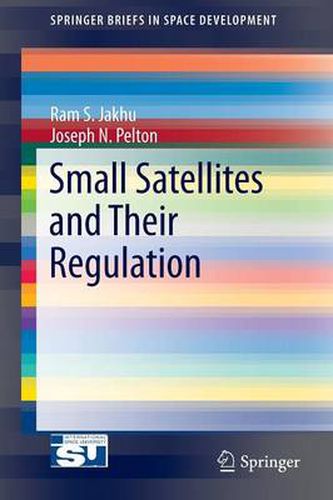Readings Newsletter
Become a Readings Member to make your shopping experience even easier.
Sign in or sign up for free!
You’re not far away from qualifying for FREE standard shipping within Australia
You’ve qualified for FREE standard shipping within Australia
The cart is loading…






This title is printed to order. This book may have been self-published. If so, we cannot guarantee the quality of the content. In the main most books will have gone through the editing process however some may not. We therefore suggest that you be aware of this before ordering this book. If in doubt check either the author or publisher’s details as we are unable to accept any returns unless they are faulty. Please contact us if you have any questions.
Since the launch of UoSat-1 of the University of Surrey (United Kingdom) in 1981, small satellites proved regularly to be useful, beneficial, and cost-effective tools. Typical tasks cover education and workforce development, technology demonstration, verification and validation, scientific and engineering research as well as commercial applications. Today the launch masses range over almost three orders of magnitude starting at less than a kilogram up to a few hundred kilograms, with budgets of less than US$ 100.00 and up to millions within very short timeframes of sometimes less than two years. Therefore each category of small satellites provides specific challenges in design, development and operations.
Small satellites offer great potentials to gain responsive, low-cost access to space within a short timeframe for institutions, companies, regions and countries beyond the traditional big players in the space arena. For these reasons (particularly the low cost of construction, launch and operation), small (micro, cube or nano) satellites are being preferred by students and educational institutions, amateur radio operators, small and developing countries, international aid agencies and most recently by defense agencies and satellite operators who are examining deployment of constellation clusters instead of conventional application satellites. In some cases these new capabilities are being deployed as hosted payloads on larger satellites. The advent of hosted payloads as a significant part of the satellite industry represents a key new topic that this book will address.
The number of small satellites-of various types–is increasing fast as their benefits are being realized. This short and unique interdisciplinary book, covering both technical and regulatory aspects, examines all the different types of applications and reasons for small as well as exploring technical and operational innovations that are being introduced. It also examines the new technical standards, removal techniques or other methods that might help to address current problems and the regulatory issues and procedures to ameliorate problems associated with small satellites, especially mounting levels of orbital debris and noncompliance with radio frequency and national licensing requirements, liabilities, export controls and so on.
$9.00 standard shipping within Australia
FREE standard shipping within Australia for orders over $100.00
Express & International shipping calculated at checkout
This title is printed to order. This book may have been self-published. If so, we cannot guarantee the quality of the content. In the main most books will have gone through the editing process however some may not. We therefore suggest that you be aware of this before ordering this book. If in doubt check either the author or publisher’s details as we are unable to accept any returns unless they are faulty. Please contact us if you have any questions.
Since the launch of UoSat-1 of the University of Surrey (United Kingdom) in 1981, small satellites proved regularly to be useful, beneficial, and cost-effective tools. Typical tasks cover education and workforce development, technology demonstration, verification and validation, scientific and engineering research as well as commercial applications. Today the launch masses range over almost three orders of magnitude starting at less than a kilogram up to a few hundred kilograms, with budgets of less than US$ 100.00 and up to millions within very short timeframes of sometimes less than two years. Therefore each category of small satellites provides specific challenges in design, development and operations.
Small satellites offer great potentials to gain responsive, low-cost access to space within a short timeframe for institutions, companies, regions and countries beyond the traditional big players in the space arena. For these reasons (particularly the low cost of construction, launch and operation), small (micro, cube or nano) satellites are being preferred by students and educational institutions, amateur radio operators, small and developing countries, international aid agencies and most recently by defense agencies and satellite operators who are examining deployment of constellation clusters instead of conventional application satellites. In some cases these new capabilities are being deployed as hosted payloads on larger satellites. The advent of hosted payloads as a significant part of the satellite industry represents a key new topic that this book will address.
The number of small satellites-of various types–is increasing fast as their benefits are being realized. This short and unique interdisciplinary book, covering both technical and regulatory aspects, examines all the different types of applications and reasons for small as well as exploring technical and operational innovations that are being introduced. It also examines the new technical standards, removal techniques or other methods that might help to address current problems and the regulatory issues and procedures to ameliorate problems associated with small satellites, especially mounting levels of orbital debris and noncompliance with radio frequency and national licensing requirements, liabilities, export controls and so on.